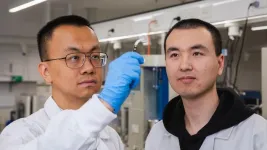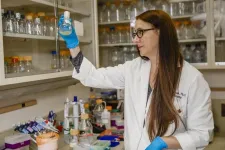(Press-News.org) The National Institutes of Health (NIH) has launched a clinical trials network to evaluate emerging technologies for cancer screening. The Cancer Screening Research Network (CSRN) will support the Biden-Harris administration’s Cancer Moonshot℠ by investigating how to identify cancers earlier, when they may be easier to treat. Eight groups have received funding from the National Cancer Institute (NCI), part of NIH, to carry out the initial activities of the network.
“There are many cancers we still cannot reliably detect until it is so late that they become extremely difficult to treat,” said W. Kimryn Rathmell, M.D., Ph.D., director of NCI. “Emerging technologies such as multi-cancer detection tests could transform cancer screening and help to extend the lives of many more people. We need to be sure that these technologies work and understand how to use them so they benefit everyone.”
Studies are needed, for example, to evaluate the benefits and harms of promising new technologies for cancer screening and to determine how best to incorporate these technologies into the standard of care.
In 2024, the network will launch a pilot study, known as the Vanguard Study on Multi-Cancer Detection, to address the feasibility of using multi-cancer detection (MCD) tests in future randomized controlled trials. MCDs are blood tests that can screen for several types of cancers. The study will enroll up to 24,000 people to inform the design of a much larger randomized controlled trial. This larger trial will evaluate whether the benefits of using MCD tests to screen for cancer outweigh the harms, and whether they can detect cancer early in a way that reduces deaths.
“Our goal is to systematically evaluate cancer screening technologies to understand how best to use them to ultimately save lives. Data collected through these clinical trials can be used to develop evidence-based guidelines for cancer screening,” said Lori M. Minasian, M.D., deputy director of the Division of Cancer Prevention at NCI.
In its studies, the network aims to reach diverse populations that are receiving routine care in a variety of health care settings. Study sites are geographically diverse and include underserved populations. Study investigators will come from a variety of disciplines that are actively engaged in cancer screening.
“We want to ensure that the organizations involved in this network will also be recruiting from populations historically underrepresented in clinical trials, which will make the data we generate as representative as possible,” Dr. Minasian said. “It is important to make sure that these new technologies benefit all Americans.”
Initial funding will provide resources for study coordination, communication activities, statistics and data management, and accrual and enrollment of participants into clinical trials and studies. Fred Hutchinson Cancer Center in Seattle will serve as the network’s coordinating and communications center and the statistics and data management center.
The seven additional funded sites will lead efforts to enroll participants in their geographic and coverage areas and include:
Henry Ford Health + Michigan State University Health Sciences in Detroit
Kaiser Permanente Northern California, Kaiser Permanente Southern California, and Kaiser Permanente School of Medicine
OU Health Stephenson Cancer Center at the University of Oklahoma Health Sciences in Oklahoma City
University of Colorado Cancer Center in Aurora
University of North Carolina Lineberger Comprehensive Cancer Center in Chapel Hill
Virginia Commonwealth University in Richmond, Inova, and Sentara Health
Washington University School of Medicine in St. Louis
The Department of Defense Uniformed Services University and the Department of Veterans Affairs will also participate as sites funded by their respective agencies.
###
About the National Cancer Institute (NCI): NCI leads the National Cancer Program and NIH’s efforts to dramatically reduce the prevalence of cancer and improve the lives of cancer patients and their families, through research into prevention and cancer biology, the development of new interventions, and the training and mentoring of new researchers. For more information about cancer, please visit the NCI website at cancer.gov or call NCI’s contact center, the Cancer Information Service, at 1-800-4-CANCER (1-800-422-6237).
About the National Institutes of Health (NIH): NIH, the nation's medical research agency, includes 27 Institutes and Centers and is a component of the U.S. Department of Health and Human Services. NIH is the primary federal agency conducting and supporting basic, clinical, and translational medical research, and is investigating the causes, treatments, and cures for both common and rare diseases. For more information about NIH and its programs, visit nih.gov.
END
WASHINGTON (Feb. 21, 2024) – Painting a sobering picture, a research team led by Children’s National Hospital culled years of data demonstrating that maternal mental illness is an under-recognized contributor to the death of new mothers. They are calling for urgent action to address this public health crisis in the latest edition of JAMA Psychiatry.
Backed by dozens of peer-reviewed studies and health policy sources, the journal’s special communication comes as maternal mortality soars ...
Researchers from IOCB Prague and Ghent University have been working on improving the properties of gelatin-based materials, thereby expanding the possibilities of their use mainly in medicine. In a paper published in ACS Applied Engineering Materials, they have presented 3D-printable materials that can be easily monitored using an X-ray machine or through computed tomography (CT).
Gelatin-based materials have been a hot topic of research in the last ten years because they are straightforward to produce, non-toxic, inexpensive, ...
In a significant advancement for next-generation semiconductors, a collaborative research team, led by Professor Kyoung-Duck Park and Mingu Kang in the Department of Physics at POSTECH, Professor Yong Doug Suh in the Department of Chemistry at UNIST, who concurrently holds the position of Associate Director at the IBS Center for Multidimensional Carbon Materials (CMCM), and Professor Hyun Seok Lee in the Department of Physics at Chungbuk National University, has made groundbreaking discoveries in the field of two-dimensional (2D) semiconductors. Their findings, published in Nano Letters, shed light on the generation and control of trions, providing ...
High-dose pressurized oxygen can stress out old immune cells, leaving behind a younger, better functioning immune system. It helped with acute COVID, and now Anders Kjellberg is testing the method for post-covid as well.
Hyperbaric oxygen therapy, giving patients 100 percent oxygen at a pressure corresponding to 10-20 meters below sea level, has been around for almost 100 years. But the method lacks modern evidence from clinical studies, which also means that there is a lack of knowledge about dosage, all patients receive the same dose.
"When I started my research, I wanted to find out how the treatment should be dosed to different patients," says ...
A groundbreaking research breakthrough in solar energy has propelled the development of the world’s most efficient quantum dot (QD) solar cell, marking a significant leap towards the commercialization of next-generation solar cells. This cutting-edge QD solution and device have demonstrated exceptional performance, retaining their efficiency even after long-term storage. Led by Professor Sung-Yeon Jang from the School of Energy and Chemical Engineering at UNIST, a team of researchers has unveiled ...
A global team of researchers and industry collaborators led by RMIT University has invented recyclable ‘water batteries’ that won’t catch fire or explode.
Lithium-ion energy storage dominates the market due to its technological maturity, but its suitability for large-scale grid energy storage is limited by safety concerns with the volatile materials inside.
Lead researcher Distinguished Professor Tianyi Ma said their batteries were at the cutting edge of an emerging field of aqueous energy storage devices, with breakthroughs that significantly improve the technology’s performance and lifespan.
“What ...
WASHINGTON—Health care providers who treat diabetes need to think beyond the clinical numbers, such as solely focusing on a person’s glucose goals. Taking the patient experience into account can improve the quality of care and facilitate attainment of treatment goals, according to a new position statement published in the Endocrine Society’s Journal of Clinical Endocrinology & Metabolism.
The position statement reflects the consensus of two virtual roundtables the Endocrine Society held in 2022. Participants ...
The Photovoltaics Research Department of the Korea Institute of Energy Research (hereafter KIER), working with the KIER Energy AI and Computational Science Lab, has achieved advancements in the stability and efficiency of semi-transparent perovskite solar cells. These cells have potential use in building windows and tandem solar cells*. The semi-transparent solar cells achieved a record-breaking efficiency of 21.68%, making them the most efficient amongst the perovskite solar cells using transparent electrodes in the world. Additionally, they showed ...
Most chronic wound infections share one thing in common: the presence of biofilms, which are composed of many different microorganisms that congregate as a mass, usually on some type of surface such as a wound bed. Biofilms are thought to be associated with up to 80% of infections, and their ability to stick together makes the biofilm and infection exceptionally difficult to kill.
To combat this health care challenge, researchers such as Kendra Rumbaugh, Ph.D., a professor in the Texas Tech University Health Sciences Center (TTUHSC) School of Medicine’s Department of Surgery, are pursuing biofilm dispersal agents such as ...
Whales and dolphins get their nutrients and essential elements through their diet. While eating fish, squid, octopus, crustaceans and other marine mammals, they are also exposed to heavy metal contaminants.
Elevated levels of toxins have been found in stranded dolphins and whales along the Southeastern Coast of the United States. Monitoring toxic contaminants in these stranded marine animals, which serve as important sentinels of environmental contamination, and whose health may be linked to human health, is vital.
Yet, data remain sparse on how specific elements are distributed within an animal’s body, especially for many rarely encountered ...







